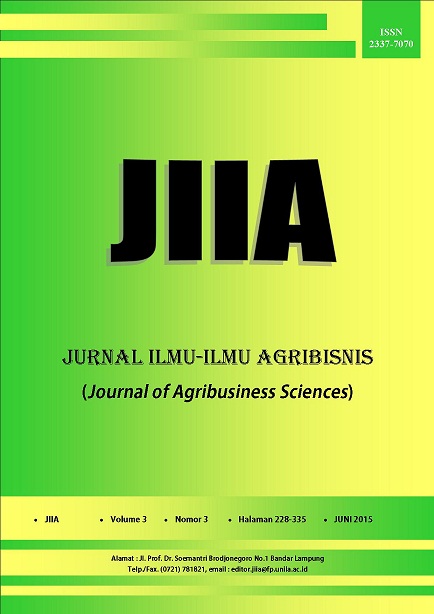PENENTUAN HARGA POKOK PRODUKSI USAHA PENGGEMUKAN SAPI: STUDI KASUS USAHA PENGGEMUKAN SAPI MILIK KASTAMAR DI KECAMATAN TERBANGGI BESAR KABUPATEN LAMPUNG TENGAH
DOI:
https://doi.org/10.23960/jiia.v3i3.1052 Abstract View: 1002
Abstract View: 1002
Abstract
This research aims to find out cost of goods production business of fattening cattle owned Kastamar by using full costing method, cost of goods production of cattle fattening owned by Kastamar using variable costing methods, revenues of cattle fattening owned Kastamar, and the cost of sold beef at butcher. The research was carried out with the method of case study on fattening cattle Kastamar, Terbanggi Besar sub district, Lampung Tengah district. Location determination research done deliberately (purposive) with the consideration that the population of cattle in Terbanggi Besar sub district, Central Lampung district was the largest cattle population in the province of Lampung, and in the location of such research has not made any calculation of the cost of goods production. Methods of data analysis methods used were cost of goods production of full costing methods, and cost of goods production of variable costing methods. The results showed: (1) the cost production of fattening cattle owned Kastamar using full costing method in period I, II, and III was Rp 40,369/kg, Rp 40,082/kg, and Rp 41,854/kg, (2) the cost production of fattening cattle owned Kastamar using variable costing method in period I, II, and III was Rp 38,115/kg, Rp 37,946/kg, and Rp 39,481/kg, revenues fattening cattle owned Kastamar to the period I, II , III was Rp 43,795,082, Rp 52,404,082, and Rp 41,866,082, cost of sold beef at butcher in the period I, II, and III was Rp 112,182/kg, Rp 111,632/kg, and Rp 112,724/kg.
Key words: beef cattle, cost of goods sold, cost of productions, full costing, variable costing
Downloads
Downloads
Published
How to Cite
Issue
Section
License
Authors who publish with this journal agree to the following terms:
Authors retain copyright and grant the journal right of first publication with the work simultaneously licensed under a Creative Commons Attribution License that allows others to share the work with an acknowledgement of the work's authorship and initial publication in this journal.
Authors are able to enter into separate, additional contractual arrangements for the non-exclusive distribution of the journal's published version of the work (e.g., post it to an institutional repository or publish it in a book), with an acknowledgement of its initial publication in this journal.
Authors are permitted and encouraged to post their work online (e.g., in institutional repositories or on their website) prior to and during the submission process, as it can lead to productive exchanges, as well as earlier and greater citation of published work (See The Effect of Open Access).














